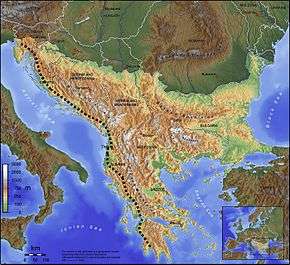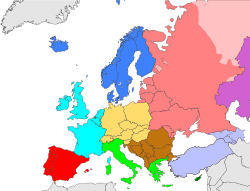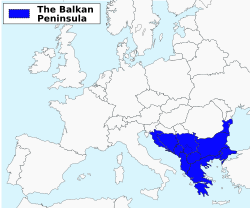Southeast Europe


Southeast Europe or Southeastern Europe (SEE) is a geographical region of Europe, consisting primarily of the coterminous Balkan peninsula. There are overlapping and conflicting definitions as to where exactly Southeastern Europe begins or ends or how it relates to other regions of the continent. Sovereign states that are most frequently included in the region are, in alphabetical order: Albania, Bosnia and Herzegovina, Bulgaria, Croatia, Greece, Kosovo,[lower-alpha 1] Macedonia, Montenegro, Romania, Serbia and Slovenia.
These boundaries can vary greatly and are widely disputed, due to political, economic, historical, cultural, and geographical considerations and point of view of the observer.
Definition
The first known use of the term "Southeast Europe" was by Austrian researcher Johann Georg von Hahn (1811–1869) as a broader term than the traditional "Balkans".[1]
Balkans model

This concept is based on the boundaries of the Balkan peninsula. The countries that have been described as being entirely within the region are: Albania, Kosovo,[lower-alpha 1] Bosnia and Herzegovina, Bulgaria, Macedonia and Montenegro.[2]
Geographical Southeast Europe
Countries that are geographically, at least partially, described to be within the region are as follows:[3]












Notable views
- The Stability Pact for South Eastern Europe (SPSEE) included Albania, Bosnia and Herzegovina, Bulgaria, Croatia, Kosovo, Macedonia, Moldova, Montenegro, Romania and Serbia as member partners.
- The South-East European Cooperation Process (SEECP) includes Albania, Bosnia and Herzegovina, Bulgaria, Croatia, Greece, Kosovo, Macedonia, Moldova, Montenegro, Romania, Serbia, Slovenia and Turkey as member partners.
- The Southeast European Cooperative Initiative (SECI) includes Albania, Bosnia and Herzegovina, Bulgaria, Croatia, Macedonia, Moldova, Montenegro, Romania, Serbia, Slovenia and Turkey as member partners.
- The EU-co-funded South East Europe Transnational Cooperation Programme includes the whole territory of Albania, Austria, Bosnia and Herzegovina, Bulgaria, Croatia, Greece, Hungary, Macedonia, Montenegro, Moldova, Romania, Serbia, Slovakia, Slovenia, and parts of Italy and Ukraine as part of the "programme area".[7]
- Studies of the World Bank treat Albania, Bosnia and Herzegovina, Bulgaria, Croatia, Macedonia, Moldova, Romania and Serbia as the eight South Eastern European countries (SEE8).[8]
- A 2006 publication of the World Health Organization (WHO) and Council of Europe Development Bank (CEB) listed Albania, Bosnia and Herzegovina, Bulgaria, Croatia, Macedonia, Moldova, Romania and Serbia and Montenegro as 'south-eastern European countries'.[9]
- The World Bank does not include the EU countries in its reports, and lists only Albania, Bosnia and Herzegovina, Kosovo, FYR Macedonia, Montenegro, and Serbia (SEE6).[10]
- CIA's The World Factbook lists Albania, Bosnia and Herzegovina, Bulgaria, Croatia, Kosovo, Macedonia, Montenegro, Romania, Serbia and Turkey (only European part),[11] but not Greece and Moldova,[12] as geographically part of Southeastern Europe.
- UNHCR's Regional Office in South Eastern Europe currently lists Albania, Bosnia and Herzegovina, Macedonia and Montenegro as part of 'South Eastern Europe'.
See also
|
|
Notes
- 1 2 3 Kosovo is the subject of a territorial dispute between the Republic of Kosovo and the Republic of Serbia. The Republic of Kosovo unilaterally declared independence on 17 February 2008, but Serbia continues to claim it as part of its own sovereign territory. The two governments began to normalise relations in 2013, as part of the Brussels Agreement. Kosovo has received formal recognition as an independent state from 113 out of 193 United Nations member states.
References
- ↑ Hösch, Nehring, Sundhaussen (Hrsg.), Lexikon zur Geschichte Südosteuropas, S. 663, ISBN 3-8252-8270-8
- ↑ Istituto Geografico De Agostini, L'Enciclopedia Geografica – Vol.I – Italia, 2004, Ed. De Agostini p.78
- 1 2 Jelavich 1983a, p. 1-3.
- ↑ Armstrong, Werwick. Anderson, James (2007). "Borders in Central Europe: From Conflict to Cooperation". Geopolitics of European Union Enlargement: The Fortress Empire. Routledge. p. 165. ISBN 978-1-134-30132-4.
- ↑ Andrew Geddes, Charles Lees, Andrew Taylor : "The European Union and South East Europe: The Dynamics of Europeanization and multilevel governance", 2013, Routledge
- ↑ Klaus Liebscher, Josef Christl, Peter Mooslechner, Doris Ritzberger-Grünwald : "European Economic Integration and South-East Europe: Challenges and Prospects", 2005, Edward Elgar Publishing Limited
- ↑ "Programme summary", South East Europe (SEE): Operational Programme, South East Europe Transnational Cooperation Programme, 28 November 2013, p. 6
- ↑ Harry G. Broadman (2004). Building Market Institutions in South Eastern Europe: Comparative Prospects for Investment and Private Sector Development. World Bank Publications. p. xviii. ISBN 978-0-8213-5776-7.
- ↑ World Health Organization. Regional Office for Europe; Council of Europe Development Bank (2006). Health and Economic Development in South-eastern Europe. World Health Organization. pp. 5–. ISBN 978-92-890-2295-8.
- ↑ "South East Europe Regular Economic Report". World Bank.
- ↑ See "Albania". CIA. , "Bosnia and Herzegovina". CIA. , "Bulgaria". CIA. , "Croatia". CIA. , "Kosovo". CIA. , "Macedonia". CIA. , "Montenegro". CIA. , "Romania". CIA. , "Serbia". CIA. , "Turkey". CIA.
- ↑ See "Greece". CIA. , "Moldova". CIA.
Sources
- Paul L. Horecky (ed.), Southeastern Europe: A guide to basic publications, Chicago: The University of Chicago Press, 1969.
- Jelavich, Barbara (1983a). History of the Balkans: Eighteenth and Nineteenth Centuries. 1. Cambridge University Press. ISBN 9780521274586.
- Jelavich, Barbara (1983b). History of the Balkans: Twentieth Century. 2. Cambridge University Press. ISBN 9780521274593.
Further reading
- Ekavi Athanassaopolou (18 October 2013). Organized Crime in Southeast Europe. Routledge. pp. 6–. ISBN 978-1-317-99945-4.
